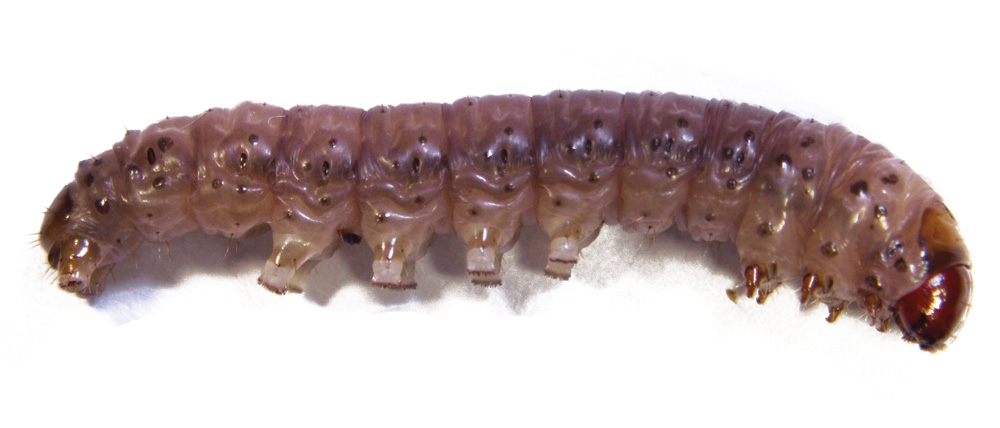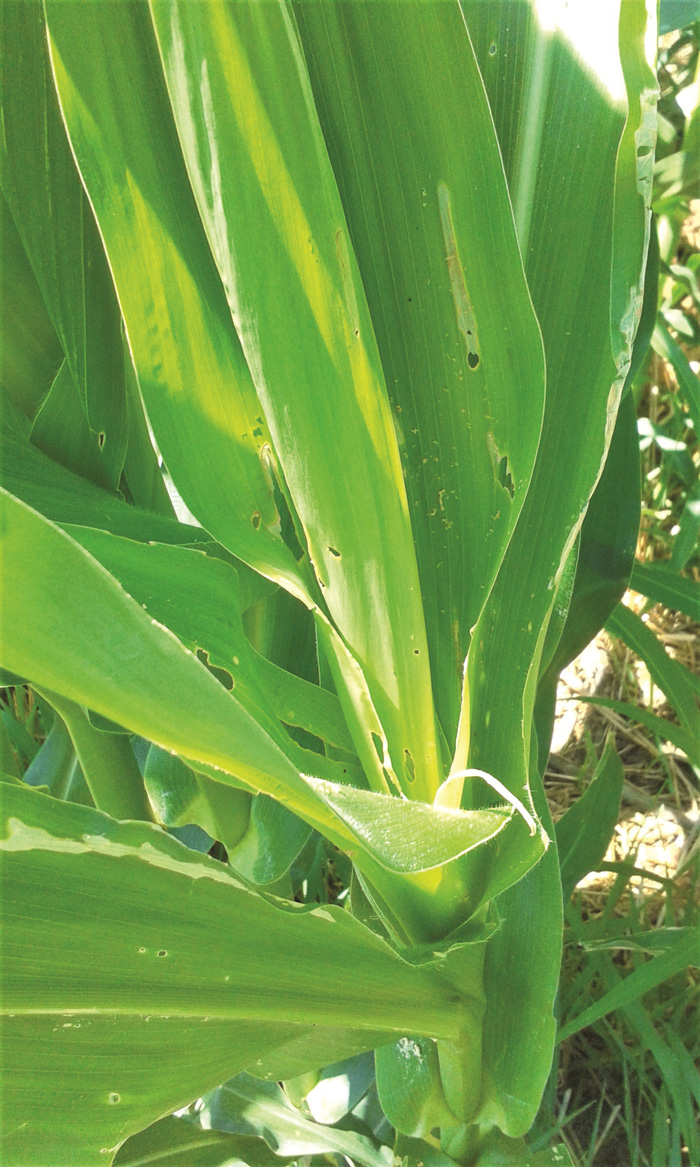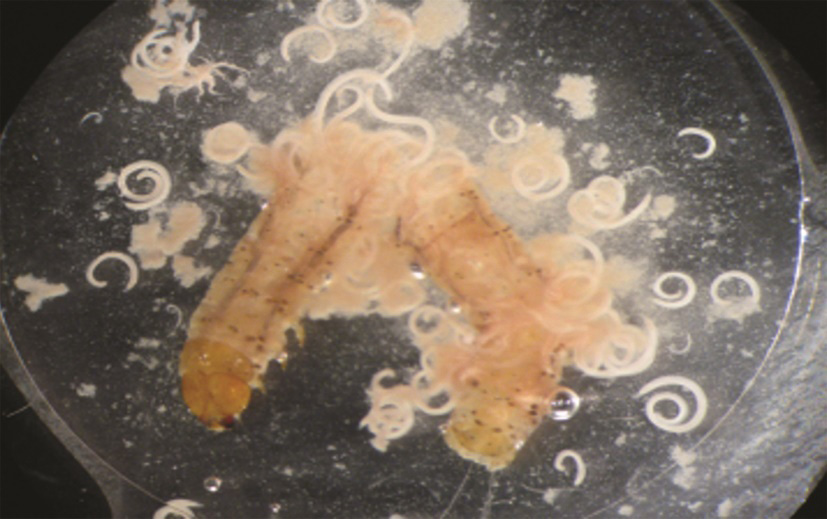
ARC-Grain Crops, Potchefstroom

Dr Sonia Steenkamp, ARC-Grain Crops, Potchefstroom
The Africa stem borer or Busseola fusca (Photo 1), is one of the most economically important pests of maize in South Africa. This pest is indigenous to Africa and distributed over the whole maize production area.
The first signs of damage caused by this borer are visible on the whorl leaves as window and shot hole damage (Photo 2). As the plant matures, larvae will migrate from the whorl leaves and bore into the stem of the maize plant. Yield losses of 10% and upwards have been recorded and in extreme cases of stem borer infestation, the entire crop can be destroyed. South African producers first started planting Bt maize for B. fusca control during 1998 (Van Rensburg, 2007).
Resistance and screening
Nine years later the first report of resistance development was published. Since then, resistance development occurred in many populations across South Africa on the single Bt gene event expressing Cry1Ab proteins (Strydom et al., 2019). These scenarios prompted annual resistance screenings that have been conducted by the ARC-Grain Crops since 2013 to timeously identify potential resistance development in species that are exposed to Bt crops. Alternative control measures currently available include chemical insecticides and biological control used in an integrated pest management system. Entomopathogenic nematodes (EPNs) show potential to be used as an alternative biological control option in cases where these resistant stem borer species survive on Bt maize.
EPNs are microscopic, soil-inhabiting nematodes that attack insects and play an important role in controlling them. Juvenile stages of these nematodes actively search the soil for suitable insects to parasitise and enter them through natural openings such as the anus, mouth and respiratory openings. Once inside the body of the insect, the nematode releases bacteria that multiplies rapidly and dissolve the organs of the insect. This nutritional ‘soup’ then serves as a food source for the nematode. Mortality normally occurs within 48 hours of infestation. Depending on the size of the insect, the life cycle of such nematodes can be completed within a week or two, releasing thousands of new juveniles into the soil to infect the next insect (Photo 3).
Currently EPNs are mass reared and used as successful biological control agents on many perineal crops. The research discussed in this article was prompted by these successes to determine whether local EPNs will also parasitise indigenous stem borer species, irrespective of their resistance or susceptibility levels to Bt maize.




Research
Diapause larvae (overwintering stem borer) of Bt-resistant and susceptible populations were collected by the Entomology Unit of ARC-Grain Crops. Heterorhabditis zealandica, H. bacteriophora and Steinernema yirgalemense, collected from infested insects during local surveys by the team of Dr Antoinette Malan from the Stellenbosch University, were the EPNs evaluated during this study.
Each nematode species was evaluated on diapause and active stem borer larvae as well as on their pupae. Larvae and pupae were infected with 100 nematodes per larva/pupa. A control group, treated with only distilled water, was included in the evaluations to ensure that the insects evaluated were healthy and did not die from diseases other than the EPNs. Treated (water-controlled and nematode-infested) larvae and pupae were placed in rearing chambers at 25 °C for 48 and 72 hours, respectively. The percentage infected and dead larvae of the nematode-infested group were then recorded and compared to that of the control group. The size of infected stem borers was recorded before they were dissected to determine the number of nematodes that successfully entered the larvae.
Results
Heterorhabditis zealandica, H. bacteriophora and S. yirgalemense were all able to infect the stem borer species evaluated. Steinernema yirgalemense showed the best potential to be used as a biological control agent because it had the highest infestation rate, irrespective of the susceptibility level of the stem borer to Bt. Onset of mortality was within three days after nematode infestation. It appeared as if larger larvae were penetrated easier and provided a better environment for the nematode to multiply. An S. yirgalemense-infested stem borer larva showed a characteristically yellow colour caused by the deadly symbiotic bacteria that the nematode released inside the insect.
These yellow larvae could be distinguished from those infested with the other two nematode species since larvae that were infected with H. zealandica appeared grey, while those infected by H. bacteriophora, were reddish in colour. Only a few nematodes were observed inside the pupae, however, which indicated that the pupae were not as easily penetrated as the larvae. On the other hand, it might be possible that a higher number of nematodes was required to infect pupae and that the 100 nematodes per pupa used during this study were not sufficient.
The study established that S. yirgalemense was able to successfully penetrate larvae and pupae, killing them within a short period of time and was able to reproduce significantly inside the insect. However, when using EPNs as biological agents, the application method thereof and the biological product formulation will be crucial because the nematodes need water to be sustained, especially on annual crops. The development of such a potential biological product will be beneficial in a possible attempt to reduce the use of harmful, broad-spectrum chemicals and to control stem borer populations that developed resistance to Bt technology.
Sources
- Strydom, E, Erasmus, A, Du Plessis, H & Van den Berg, J. 2019. Resistance status of Busseola fusca (Lepidoptera: Noctuidae) populations to single and stacked-gene Bt maize in South Africa. J. Econ. Entomol., 112(1):305-315. 10.1093/jee/toy306
- Van Rensburg, JBJ. 2007. First report of field resistance by the stem borer, Busseola fusca (Fuller) to Bt-transgenic maize. S. Afr. J. Plant Soil, 24(3):147-151.



























